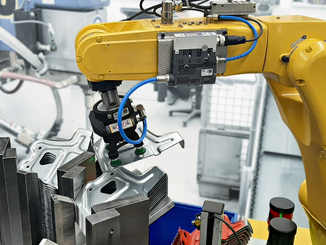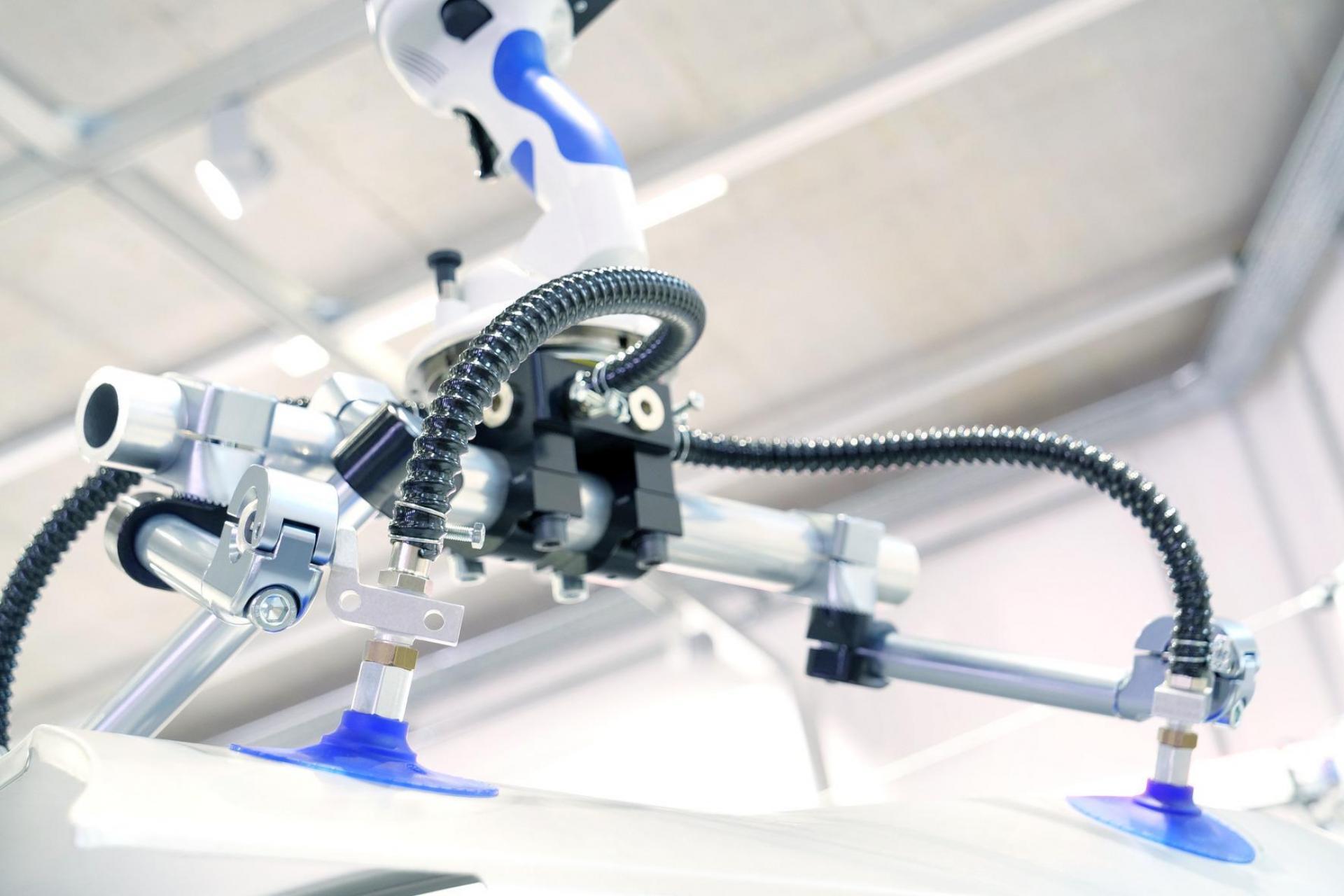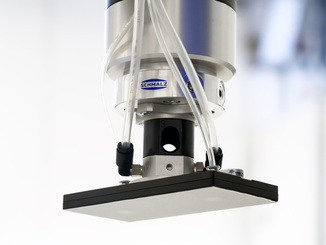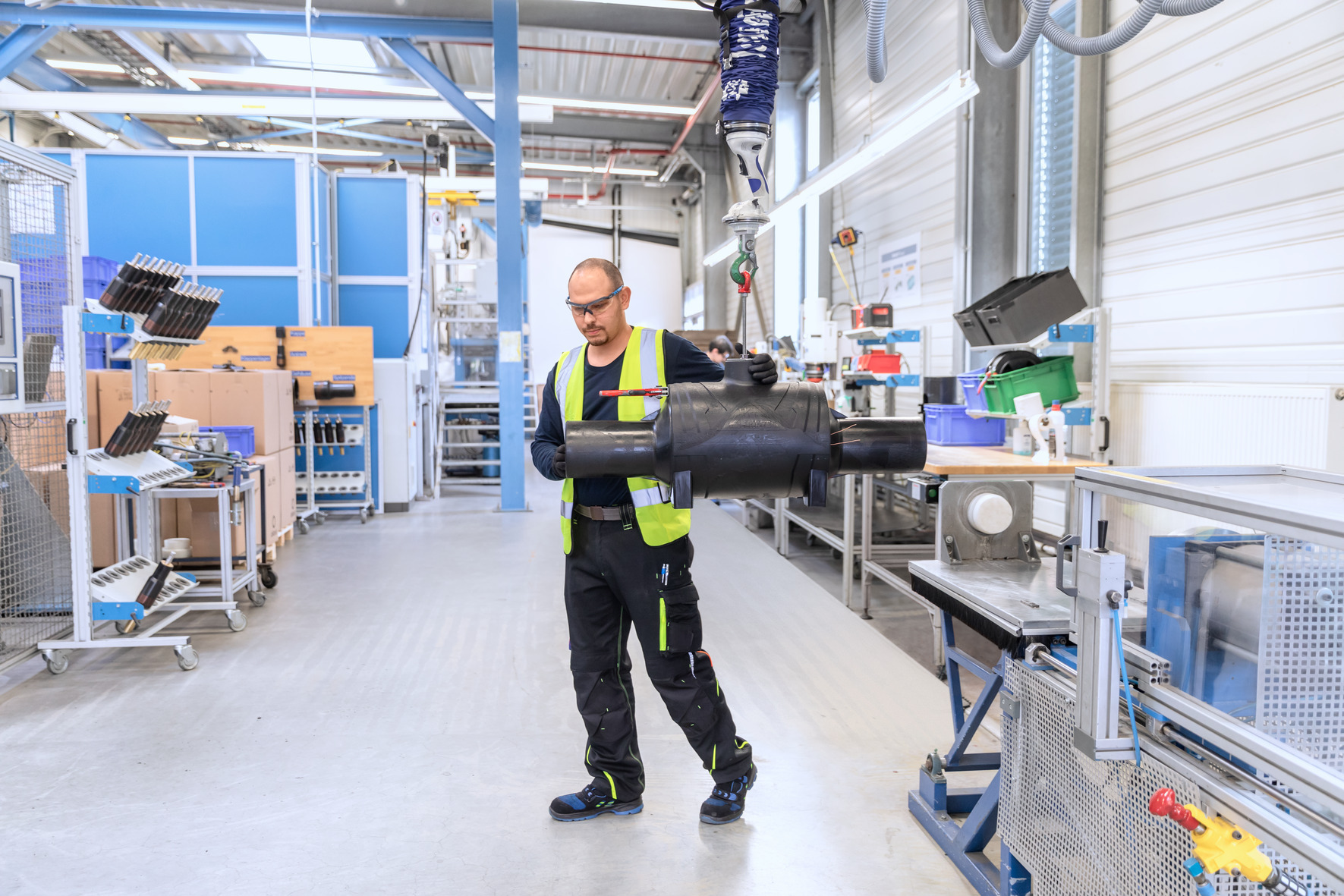
A tour of the production halls of Aliaxis Deutschland GmbH shows just how versatile the Schmalz JumboFlex is. Again and again, a silver crane boom and the blue protective hose of the vacuum lifter flash through between the plants. However, as similar as the crane and tube lifter appear from a distance, their configuration is very individual. This diversity is one answer to the question of why the ergonomics solution from Glatten is so present here.
Safety begins at the factory gate. Visitors to the Aliaxis plant in Mannheim swap their street shoes for toe-protective versions, don an orange high-visibility vest and pick up their safety goggles. It is mandatory when entering any hall. Black and yellow railings separate pedestrian walkways from the roadway, and crosswalks indicate the intended path across the street. Swinging doors block the way in front of hall doors so that forklifts and people do not collide.
A cold chimney shows where the company came from: at the end of the 19th century, pipes, troughs and tubs made of cement and clay were fired here. The products of Friatec GmbH then as now conduct gas or fresh, gray and black water. Over time, plastic has replaced stoneware. Friatec has been part of the Belgian Aliaxis Group since 2003 and has been operating under the name Aliaxis Deutschland GmbH since 2019. The Friatec brand remains unaffected. Today, 500 employees work five to seven days a week to supply customers such as municipal utilities, distributors and pipe layers with connection technologies for piping systems in a timely manner.
Plant Manager Christian Lang takes occupational safety regulations seriously. He knows what can happen: He also regularly receives the Group-wide e-mail distribution list that documents all reportable occupational accidents. “Injuries caused by machines hardly ever happen anymore. The situation is quite different with absences due to musculoskeletal disorders,” reports the plant manager at Aliaxis Deutschland GmbH. To combat this, he started a program about two years ago. The goal: to enforce international standards in occupational health and safety on a group-by-group basis. The ‘Lifting and Carrying’ initiative was launched. “To do this, we purchased vacuum lifting aids from Schmalz,” Lang reports. Five exemplary applications distributed over the 140,000 square meter plant site make ergonomic working a tangible experience.
It is surprisingly warm in the halls. Injection molding machines tirelessly transform black plastic granules – mostly polyethylene – into sleeves, tees and elbows. If possible, robots take over the monotonous and usually physically stressful removal and placement on conveyor belts. But sometimes it takes human flexibility and coordination skills to package goods, test equipment or assemble fittings. Such a shut-off valve weighs up to 40 kilograms, depending on its size. Each shift, the fitter has to lift nine to 15 of these Frialoc series valves from the assembly table into a welding jig. Until just under two years ago, the employees helped themselves with an engine hoist – or balanced the fittings around with pure muscle power. Today, a column-mounted slewing crane from J. Schmalz GmbH stands next to the workbench. A JumboFlex 50 rests on it with a suspension hook as a load receptor, which the worker hooks into an eye specially screwed into the workpiece. One touch and the tube lifter lifts the fitting. Without resistance, the transport hanger follows the movement of the operator, who then lowers the valve into a fixture. By means of electrofusion welding, the worker reliably and permanently joins the individual components. “Younger employees in particular see the benefit. They know that they still have a long working life ahead of them,” reports Christian Lang.
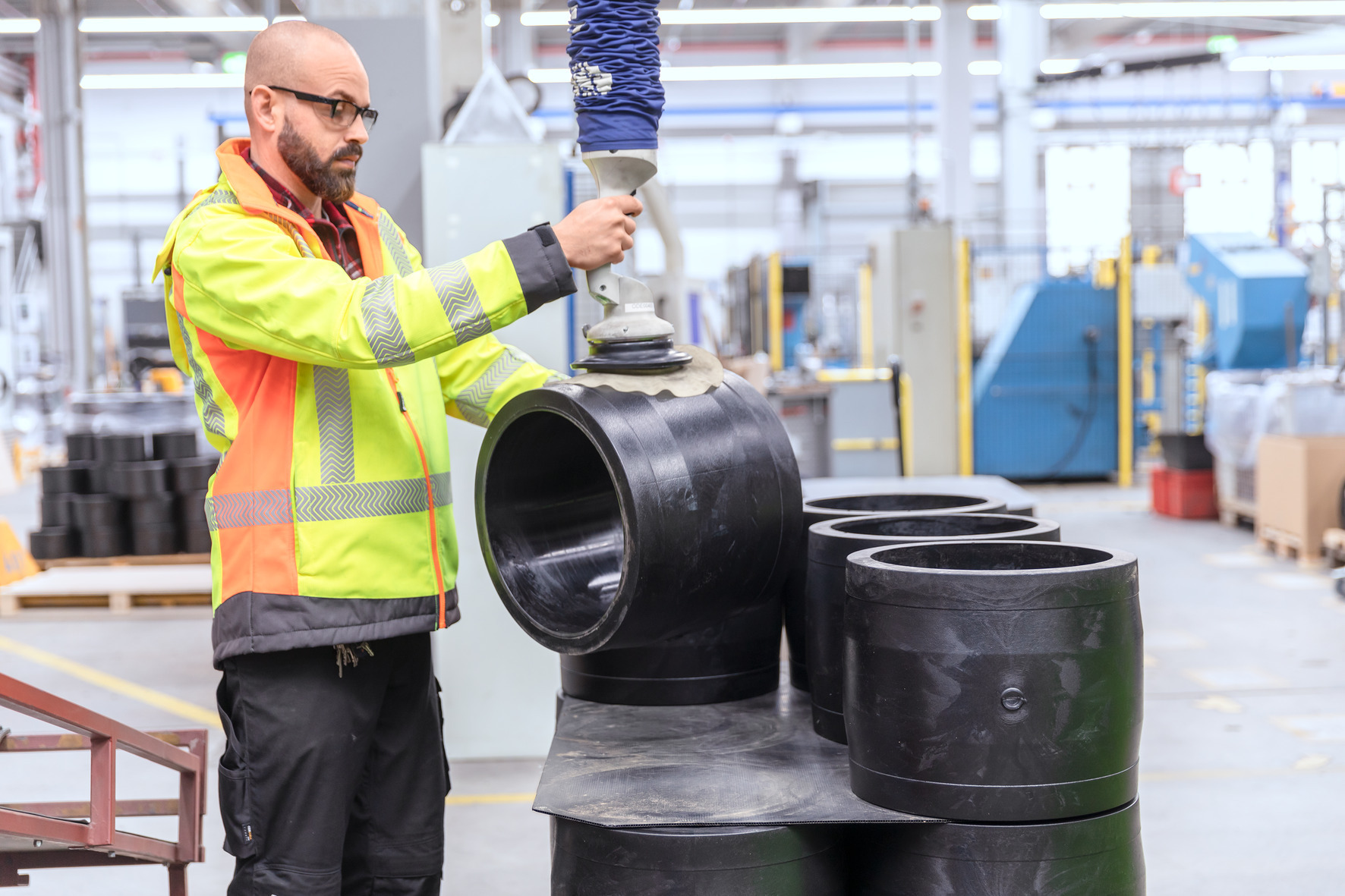
© J. Schmalz GmbH
Multiple instead of quadruple
Without any danger, we enter another production hall. Just behind the door is a modern individual workstation where workpiece carriers make a brief stopover on a transport system. They wait until a skilled worker inserts a metal cartridge into the fixed fitting or they remove and package the finished component. He has help when handling the small 25-kilogram cartridge boxes as well as the unwieldy ten-kilogram shipping cartons: to the right of the ergonomic workstation is a column-mounted slewing crane anchored in the floor with a JumboFlex 35. The aluminum jib is shortened so that it can swing just to fit past a wall projection. Until recently, the employee here used a quadruple suction pad – ideal for the large shipping cartons.
There was no solution for the smaller and heavier packaging units of the brass cartridges. Aliaxis was faced with the choice of asking the supplier for smaller packaging sizes or adapting the tube lifter. “Changing grippers would be possible with the quick-change adapter, but it would be more time-consuming,” explains Lang. Schmalz suggested the multiple suction pad. Thanks to its minimum occupancy rate of 75 percent, it also tolerates surfaces that fall short of the gripper dimension. Safety during lifting and swiveling is still guaranteed. All it took was a more powerful vacuum pump. The experience of the specialist disproves the fears of her team members: With the JumboFlex, the worker is faster than without thanks to universal gripping.
Well trimmed
A completely different challenge awaits in what is known as production 5. The JumboFlex is in use at a secondary location: sleeves weighing ten to 15 kilograms slide off the treadmill into a collection basket at ten-minute intervals. From time to time, virtually on the side, a worker stacks them upright on a pallet – up to 110 pieces per day. To take the strain off him in the process, Aliaxis looked to Schmalz for a solution that would hold securely on the curved surface, even during uprighting. The vacuum experts combined a JumboFlex 35 with a round suction pad with silicone skirt. This can be swiveled 90 degrees and allows manual alignment of the load. The bellows suction cup, which was originally designed for plastic bags and shrink-wrapped packages, proves that it can handle even more complex geometries one hall further on.
Here is a mesh cart with black tees waiting on several levels. A worker lifts them from the trolley onto the device of the wrapping line, removes them for further processing steps and then packs them. Eighty times per shift.
Until February 2022, this was all done with pure muscle power. “The fact that we had to change something here was also evident from the one or other downtime,” reports Production Manager Jens Eckstein. The challenge lies in the different geometry of the workpieces – here, both angle and T-shaped fasteners receive the wire required for subsequent electrofusion welding – and the removal from the stack car. “We wanted a gripper that was suitable for every workpiece and every handling process. Schmalz was the only supplier that could reliably handle the gripping of the T-pieces,” says Eckstein. Since the various workpieces weigh between ten and 13 kilograms, a JumboFlex 35 is also sufficient here. It is suspended from a column-mounted slewing crane equipped with a special accessory: the V-Chain drag chain. It reliably packs the vacuum supply hose package and keeps the area below the boom free. This is necessary because the aluminum boom swivels over the winding line and the manual work station.
This investment is one of the most recent, and Jens Eckstein still remembers the cooperation with the vacuum experts well: “Schmalz was right outside the door with a test device. We brought in some of our employees so that they could test the application and handling themselves. That worked flawlessly.” The production manager also notices that the team has accepted the ergonomic lifting aid in terms of sick leave: “Back problems are hardly a reason for absenteeism here anymore.”
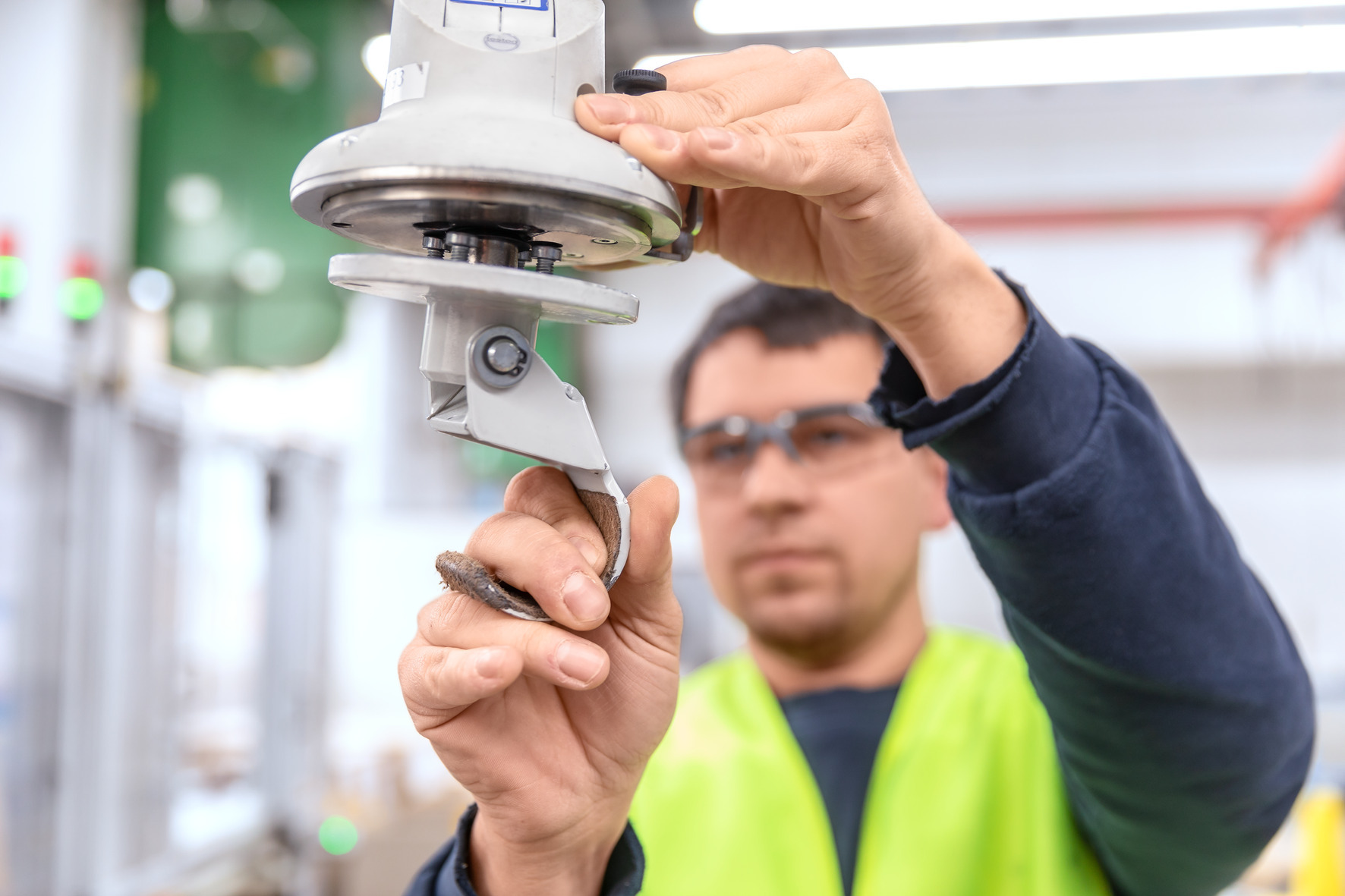
© J. Schmalz GmbH
What’s the catch?
Suspension hooks, multiple grippers, round suction cups with silicone skirt – they make the JumboFlex configurations, which are almost identical right down to the operating handle, unique. The different load suspension variants are used according to their strengths and can be changed quickly if required. This function plays an important role in the final inspection of Friamat welding equipment. This will take place in a smaller hall. There is a quiet working atmosphere. The vacuum generator is located in the connected warehouse together with the acoustic enclosure, because no one here wants to do without the JumboFlex. The column-mounted slewing crane is located next to the testing equipment for the welding machines used by pipe fitters to irreversibly join the joints, tees and elbows on the construction site. Initially, the suspension hook is mounted on the JumboFlex. With it, the technician lifts the fully assembled unit into the station and starts the 20-minute test run.
Once it has passed this, it goes into a transport case – floating on the tube lifter. Shipping is in a cardboard box. In order to stack it on the pallet in a way that is easy on the back, the worker changes the hook for a double suction pad in just a few steps. Now it’s just a matter of: Where is the hook so that he can check the next 18-kilogram device? In total, he manages about 16 test runs per day.
Plant Manager Christian Lang rates Schmalz “as a reliable and competent partner.” He appreciates the fact that the crane, tube lifter and load handling attachment come from a single source and that he receives a tested overall system. Because optimally matched components protect against accidents during operation. “Safety really does come first,” Lang concludes, bringing the demonstration round to a close. At the factory gate, it is necessary to hand in the high-visibility vests and safety goggles again and leave the safe factory premises in your own shoes – on the demarcated pedestrian path, of course.
Web:
www.schmalz.com

